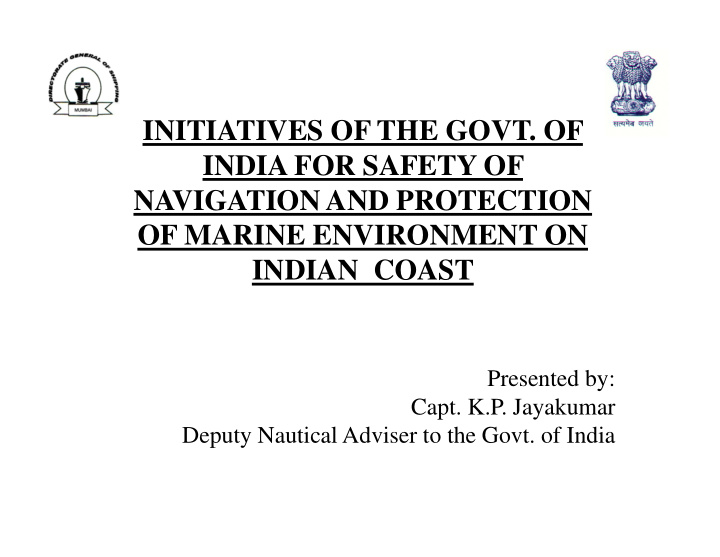



INITIATIVES OF THE GOVT. OF INDIA FOR SAFETY OF NAVIGATION AND PROTECTION OF MARINE ENVIRONMENT ON INDIAN COAST Presented by: Capt. K.P. Jayakumar Deputy Nautical Adviser to the Govt. of India
OVERVIEW • Traffic density on west coast of India. • Need for monitoring. • Monitoring systems (land based & satellite based). • Navigation & Communication systems. • Future outlook.
TRAFFIC DENSITY (ON WEST COAST OF INDIA) • High traffic convergence on west coast of India (from Persian Gulf and Gulf of Aden). • The traffic generally traverses Sri Lankan waters and Malacca Straits. • Approximately 650 vessels in a day navigate within 30 miles off the coast of India.
SNAPSHOT OF TRAFFIC CONVERGENCE/ DIVERGENCE APPROX 50 NAUTICAL MILES FROM INDIAN COAST
TRAFFIC DENSITY (ON WEST COAST OF INDIA) • High Risk Area (HRA) has forced vessels to move close to Indian coast for security. • Fishing vessels tend to move deeper into sea for better catch. • Increase in coastal traffic. • Increase in oil exploration and deep sea activity.
NEED FOR MONITORING • Increase in traffic density, speed and size of vessels. • Recent casualties with fishing vessel. • Eco-sensitive areas on the coast of India. (Lakshadweep Island). • Lack of an approved traffic separation schemes (TSS). • Oil exploration on west coast of India. • Need for maritime security and domain awareness.
MONITORING SYSTEMS – LAND BASED • Vessel Traffic Management System (VTMS) – Operational in Gulf of Kutch as well as at Mumbai harbour and its approaches. • Automatic Identification System (AIS) - A land based system established around the coast of India consisting of 72 base stations on the light houses.
DGLL INDIAN NAIS BASE STATIONS
MONITORING SYSTEMS – SATTELITE BASED (1) Long Range Identification & Tracking (LRIT) system. • The National Data Centre has been operational from August 2009 and has Completed IMSO Audit successfully on 14th Sept. 2010. • Can track Indian vessels all over the world & all vessels within 1000 N miles of the coast of India. • Capable of providing services to other countries as Regional Data Centre [RDC]. Presently, provides LRIT services to Sri Lanka and discussions are ongoing with neighbouring countries to extend facilities to them.
THE INDIAN LRIT SCREEN SHOT SHOWS VESSEL DENSITY & TRAFFIC FLOW TRANSITING THE INDIAN SUBCONTINENT. APPROXIMATELY 2200 FOREIGN & INDIAN VESSELS ARE INSIDE THE 1000NM POLYGON.
MONITORING SYSTEMS – SATTELITE BASED (2) Satellite based AIS monitoring system of ISRO • India’s remote sensing satellite launched in December 2014 carries on board Space-Based Automatic Identification System receiver (AIS- SB) capable of receiving AIS Signals from ships. • The AIS-SB can monitor the movement of all Indian ships on a round-the-clock basis irrespective of their location and can co-ordinate rescue and relief operations whenever required. • On 28th September 2015, additional equatorial orbiting satellite was launched which will give satellite AIS positions more frequently in our area.
TRAFFIC DENSITY FROM ISRO’S SATTELLITE BASED AIS APPROX 650 VESSELS ARE TRANSITING IN THE SHADED POLYGON FROM DONDRA HD TO KARWAR
TRAFFIC DENSITY FROM ISRO’S SATTELLITE BASED AIS APPROX 650 VESSELS ARE TRANSITING IN THE SHADED POLYGON FROM DONDRA HD TO KARWAR
NAVIGATION AND COMMUNICATION SYSTEMS (1) Indian Regional Navigation Satellite System [IRNSS] of ISRO. • The IRNSS is an autonomous regional satellite navigation system developed by the Indian Space Research Organization [ISRO]. • Seven satellites with the prefix "IRNSS-1" will constitute the space segment of the IRNSS, out of which, four are already placed in orbit. • Three satellites will be placed in Geostationary orbit and 4 in Geosynchronous orbit
NAVIGATION AND COMMUNICATION SYSTEMS (1) • IRNSS-1A, the first of the seven satellites was launched on 1 July 2013. • IRNSS-1B was launched on 4 April 2014 and was placed in geosynchronous orbit. • IRNSS-1C was launched on 16 October 2014. • IRNSS-1D was launched on 28 March 2015. • Three more navigational satellites will be launched by middle of 2016 and the constellation of seven satellites is expected to operate from 2016 onwards.
NAVIGATION AND COMMUNICATION SYSTEMS (2) Differential Global Positioning System (DGPS) System • It is a Satellite based system, where errors in Global Positioning System (GPS) are accurately calculated at a fixed surveyed point and then transmitted by MF Beacon (285-325 KHz). • In the coverage area of 100 - 150 NM, the position can be fixed to an accuracy of better than 5 metres. • India has established 23 DGPS station to cover the entire Indian coast.
NAVIGATION AND COMMUNICATION SYSTEMS (3) GPS Aided GEO Augmented Navigation [GAGAN] of Indian Space Research Organization [ISRO]. • It is similar to DGPS with much greater accuracy of position in all 3 dimensions. • It provides satellite based navigation service with accuracy and integrity required for civil aviation applications and to provide better air traffic management over Indian Air space.
NAVIGATION AND COMMUNICATION SYSTEMS (4) Navtex system: 7 stations covering the east and west coast of India extending to Andaman Island.
������������������������ ������������������������ ������������������������ ������������������������
������������������������ ������������������������ ������������������������ ������������������������
FUTURE OUTLOOK –I Jointly develop traffic separation schemes for • maritime safety with the neighbouring countries. Mutual co-operation and formation of • Regional Groups for monitoring and tracking of all maritime traffic with Mauritius, Maldives and Sri Lanka. Extension of facilities to neighbouring • countries including the Bay of Bengal Rim countries. Merger of monitoring systems with other • Regional groups (Straits of Malacca and Persian Gulf) for seamless integration.
FUTURE OUTLOOK –II Expansion of the Indian Regional Navigation • Satellite System [IRNSS] and recognition for the system at International level. Development of E-navigation on the coast of • India and extending the facility to Sri Lanka and other neighboring countries with ‘Make In India’ objective. Use of digital and space based technology for • Maritime Domain Awareness towards safer navigation and protection of marine environment.
THANK YOU
Recommend
More recommend